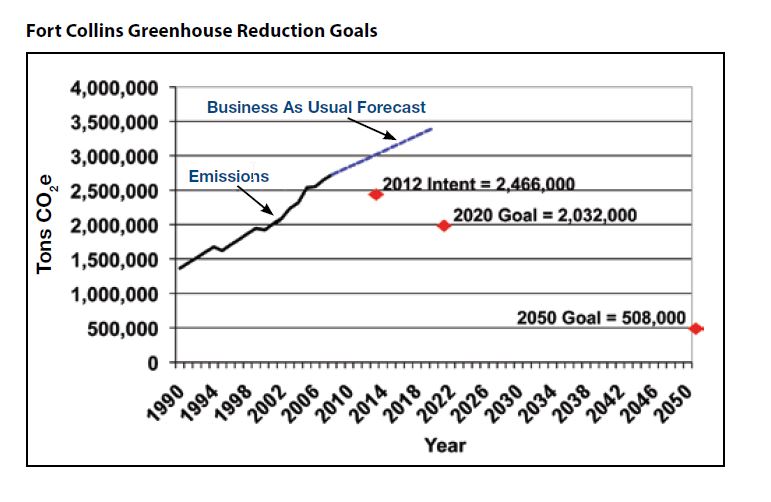
Jurisdiction: Fort Collins, CO
Plan Year: 2008
Progress Report Year: 2013, 2012
Background:
Fort Collins updated its 2001 Climate Action Plan in December 2008, adopting GHG emissions targets of 20% reduction by 2020 and 80% reduction by 2050, compared to 2005 levels. In 2014, the city issued a resolution to consider developing a new, more aggressive CAP to achieve 80% reduction by 2030 compared to 2005 levels and carbon neutrality by 2050. In its 2013 Status Report, the city recognizes the potential challenge of such ambitious new goals, as an increasing population and economic activity led Fort Collins to experience small increases in GHG emissions in 2013 and 2012. However, the overall community emissions are still down by close to 5% and per capita emissions are down 17.7%, compared to 2005 levels.
One interesting feature of this plan is its inclusion of upstream emissions in its emissions inventory. In order to "take credit" for upstream reductions in emissions resulting from community recycling, the City's inventory includes the upstream emissions associated with producing targeted recovered materials that are landfilled. Thus, a reduction in landfilling and increase in recycling and composting allows the City to "reduce emissions" compared to the new baseline inventory.
Materials Management Goals:
- 2008 plan goal: 50% diversion
- 2013 City Council goal: 75% diversion by 2020 and zero waste by 2030
Strategies:
- Target specific materials including electronics, cardboard, paper and glass, construction and demolition materials
- Yard waste collection
- Enhanced Pay-As-You-Throw
- Commercial recycling co-ops
- Ban cardboard from waste stream
- Increase residential education
Progress Report:
2013:
- Waste Reduction and Recycling Assistance Program (WRAP) began in 2012 and reached over 7,500 individuals in 2013
- Banned landfill disposal of cardboard in 2013 – cardboard-only collection increased by 94.8 % in first nine months
- Increased concrete recycling by 85% and asphalt recycling by 24 % since 2012
- Community diversion rate (including residential, commercial, and industrial materials) increased 5.9% between 2012 and 2013
2012:
- Municipal solid waste diversion rate dropped 5% from 2011 to 2012
- Recycling rate grew 16%
- Cartons like beverage containers were added to single-stream recycling program in 2012
- Helped register 1,608 residents opt out of junk mail, preventing 20 tons of unwanted mail
- Recovered over 110,000 tons of asphalt, concrete, and aggregates to be made into new road-based materials
Next Steps:
In December 2013, City Council adopted new targets of 75% diversion rate by 2020 and zero waste by 2030. It also set a goal to reduce the generation of annual landfilled material per resident to 2.8 pounds by 2025. As a result of the 2014 City Resolution that steps us the emissions goal to 80% reduction compared to 2005 levels by 2030 and carbon neutrality by 2050, Fort Collins will likely be working on a new CAP and strategies that accompany it.
Links:
